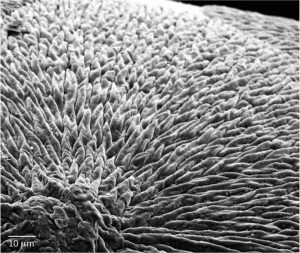Regenerating dental enamel
A new study, published in Nature Communications, outlines a method of growing mineralized structures with the same properties as dental enamel. The materials could be used for repairing enamel, which – unlike other tissues of the body – is not regenerated by the human body once lost.
Enamel loss
Enamel is the hardest substance in the human body. It is found on the outside of teeth and serves to protect them from damage related to biting forces, acidic foods and extreme temperatures. Despite its hardness, enamel is susceptible to decay and erosion due to bacteria. Once it is lost, enamel cannot regenerate.
Lost enamel can lead to pain and tooth loss, and these issues impact a large portion of the population. According to the CDC, tooth decay is the most common chronic disease affecting children and adolescents ages 6-19. In addition, 9 out of 10 adults have some degree of tooth-root decay. Scientists have therefore been striving to develop ways to effectively recreate enamel.
New mineralization process

Close-up of the enamel-like material. Credit: Alvaro Mata, Queen Mary University of London.
In the new paper, the researchers, led by a team from Queen Mary University of London, developed mineralized materials that could regenerate hard tissues like enamel and bone. The mineralization process can be controlled with high precision, creating highly organized structures that look and behave like enamel.
The process uses macromolecules called elastin-like recombinamers to guide the growth of nanocrystals in a way similar to natural enamel development. The resulting material emulates enamel with high stiffness, hardness and acid resistance. It can be created as a fully mineralized membrane or coated over native tissues.
Regenerating dental tissues
The scientists hope their technique can be used in the prevention and treatment of tooth decay and tooth sensitivity. The new mineralization process may also open opportunities for regenerating other hard tissues, such as bone and dentin.
“This is exciting because the simplicity and versatility of the mineralization platform opens up opportunities to treat and regenerate dental tissues,” lead author Dr. Sherif Elsharkawy said in a press release. “For example, we could develop acid resistant bandages that can infiltrate, mineralize, and shield exposed dentinal tubules of human teeth for the treatment of dentin hypersensitivity.”
If you work in this area of research, you might be interested in one of our antibodies from Dr. Larry W. Fisher at the NIH’s National Institute of Dental and Craniofacial Research. He has made available 30 antibodies for detecting dental-related proteins found in cartilage, bone and other tissues. Targets include dentin matrix protein-1 (DMP1), dentin sialophosphoprotein (DSPP) and decorin. View the full antibody list here.


